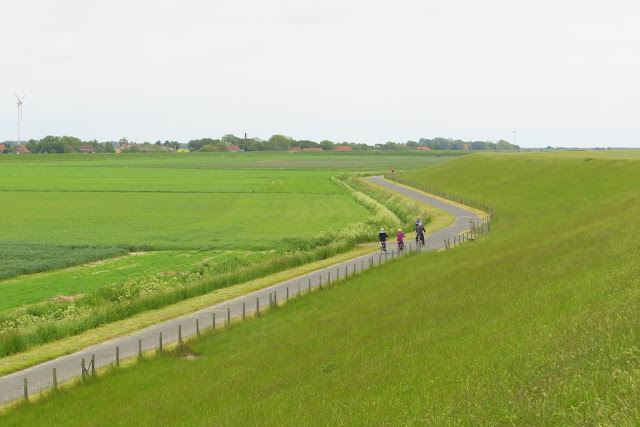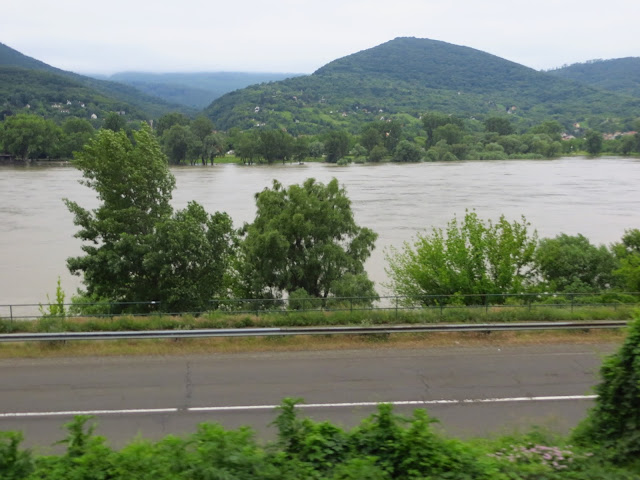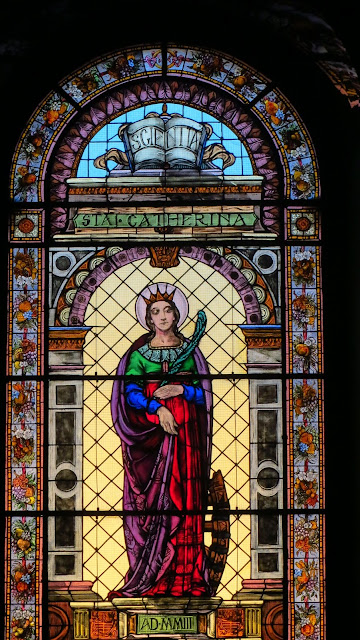The first
half of our ride from Vienna to Budapest was on easy, well-built trails. The second half, starting in Győr, alternated between country roads and rather bumpier
trails, with a few segments of busy roads thrown in.

We
left Gy
őr following the blue Eurovelo
Route 6 signs using low-traffic streets, then a 4 km trail that appears to have
been converted from a train line. For 3
km EV 6 next had us riding on a dirt road that made us happy we had put wider
tires on for this trip. Finally we came
to a rural highway that was not overly wide, but not at all busy, either. A car passed us about once every 2 or 3
minutes, always with no problem to pass well wide of us.

About 25
km past Győr we came to an important
turning-point, where we left EV 6 and the directions in our Bikeline Guide to Biking From Vienna to
Budapest, and took an alternate route to the small town of Tata. Jeff had printed out a map on the computer
back home which made it look easy, and indeed it was despite Hungary's scarcity
of road signs. Twice we turned to a
pedestrian, pointed where we thought we were supposed to go, and said
"Tata???" Each time we got a
sentence or two of Hungarian, but a smile and facial expression were easy to
translate as "Yup!"

We
chose Tata as a destination because the usual overnight destination, Komarom,
didn't sound that interesting, and Tata had three possible attractions: an old
mansion of the Eszterhazy family, an old castle, and a lake. It would also be an adventure and force us to
climb a ridge 400' above the Danube where we might get some views. In the end, these last two
were the main advantages. Our small inn was across a mill stream from
the castle and a block from the lake, so we did get to enjoy their pleasures,
but they were quite modest ones. The
Eszterhazy mansion was in need of so much repair work that we were too
embarrassed to even take its photo. The
once grand parish church was in only slightly better shape, and illustrates the
reality that Tata is not yet one of the communities prospering in the post-1989
world. But there were some elegant homes
under construction along the lake nearby, so perhaps Tata's day is coming.


The ride
over the ridge back to the Danube put our biking preparedness to the test, as
it included a kilometer and a half of climbing at 7%, about the limit of what
we care to do anymore. And we did make
it in our lowest gear, 27th. We never
had to go to "28th gear," our euphemism for walking.
The
descent took us through wine country and indeed past excellent viewpoints
across the Danube to Slovakia, including the small town of Radvan,
Slovakia. The road was so steep and
bumpy that we had our drag brake on full, and even so we had to use the rim
brakes so much that we stopped twice for 1-2 minutes to let the rims cool. We know three people who have had tire
blow-outs from rims that got so hot they melted the tubes!
This now
put us on National Road 10, a road no wider than the one we showed you a few
photos up, but busier. We had 9
kilometers that we tried to do as fast as possible, which was 24 kph (15 mph),
a speed we were happy with considering we had a headwind. A fair number of vehicles passed us, 1 or 2
of which felt rather too close for comfort.
We had one more 5 km stretch that day and 4 km the next on busy national
roads, and hope similar stretches are few and far between when we start biking
west from Vienna next week.
Our next
destination was Esztergom, home to the largest and most important church in
Hungary. Cardinal Mindszenty was
archbishop of this church and thus leader of the Catholic church in Hungary
when he was arrested here on Christmas Day, 1947 and charged with crimes
against the state, becoming a pawn in the Cold War for the rest of his
life. The Hungarian Revolution of 1956
is the first foreign news event Jeff remembers being aware of as a child, and
he recalls how Cardinal Mindszenty was freed from prison during the uprising,
then had to take refuge in the American Embassy when Russian troops crushed the
rebellion. He remained there 15 years, and never again saw his beautiful cathedral at Esztergom.



The
cathedral is an enormous church, made
all the more imposing because it sits next to an ancient castle on a hill that
towers over the Danube. From the old
castle ramparts behind the church we could look upriver to the Maria Valeria
Bridge connecting Slovakia with Hungary.
It was built in 1895 and destroyed in WW II, but not reconstructed until
2001.
From
those ramparts we also looked ahead to the next day's ride through the Great
Bend of the Danube, just beyond Esztergom, where it goes from east-flowing to
south-flowing, simultaneously cutting
through the Visograd Mountains.
Leaving
town we had 6 easy km on a bike trail close to the Danube, then our last 4 km
on the national road, luckily not too busy.
The remaining 80 km into Budapest were all on bike trails or side
streets, but about a fourth of that distance was fairly bumpy, particularly one
5 km stretch of dirt trail on top of a dike.
But we'll take a bumpy trail over a narrow busy road every chance we
get.
We took a
ferry across the Danube right after the Slovakian border turned away from the
river, i.e. where it began to be Hungary on both shores. The current is so strong that the ferry
crosses by pointing upstream and just a little towards one shore or the other,
to keep from washing dwnstream. Looking
upstream, the hills on the right are the last we will see of Slovakia until we
return through parts of it on our train trip back to Vienna.
15 km
downstream we were about to finish our passage between the mountains when the
high point, literal and figurative, appeared: the ruins of the Visograd
Castle, up there above Louise's right shoulder. Quite a few boats went by in the
hour we lingered over lunch, including a typical ultra-narrow river boat that
the local ferry had to wait for by running in place in the middle of the river.
Our next
overnight was on an island in the Danube, in the countryside 2 km from a
village with the intriguing name of Szigetmonoster. All our overnights in Hungary included
breakfast, always with cheese, cold cuts, a few fresh veggies like peppers,
cucumbers and tomatoes, plus yogurt, pastries and eggs. The Rosinante Country Inn, however, had an
omelet chef with various veggies before him.
You pointed, he cut, he cooked, you enjoyed.


With
help lowering our big bike on, we took a foot ferry to Szentendre, hoping to
visit an open air museum outside town where old buildings from around Hungary
have been gathered. However it rained
all morning so we parked our bike at a pension (a cross between a small hotel and
a B&B) and walked the town instead.
It was very quaint, but because it is and because you can get there by
suburban train or boat from Budapest, it had far too many shops selling tourist
kitsch. One such shop caught our
attention, however. It had knickknacks
with reproductions of famous Gustav Klimt paintings, including "The
Kiss" that we saw a week ago in Vienna, and "Portrait of Adele
Bloch-Bauer," a painting that was stolen from the Bloch-Bauer family after
the Nazis annexed Austria and only returned to them after a bitter lawsuit,
less than a decade ago. In fact, we both
just read a wonderful book about it all, "The Lady in Gold."






At last,
Budapest! We arrived coming down the west bank, and stopped for a view across
the river of the over-the-top gothic masterpiece that is the Hungarian
Parliament. That evening we walked up
closer along the east bank for more photos of it and of the city taking on its
nighttime magic.

By
the time we returned to St. Stephan's Basilica, it was night. We rented an apartment that looked out at the
basilica (it's just to the left of the church in the photo) for less than the cost of a
mid-range hotel in an inconvenient location, thanks to Booking.com. It was a great base for exploring the
city. In three nights and two days we
hit most of the sights. Here are a few
of the best shots.
Since we
had an apartment, we cooked in two evenings and made an interesting discovery:
tourists visit restaurants, so restaurants have menus in multiple
languages; tourists do not visit grocery
stores, so . . . We did a certain amount of guessing as to what we were
purchasing. It all tasted fine, though.

Then
there was the washing machine. In this
case, you had to figure out the meaning of some fairly cryptic icons. Our first batch put in creases, so we ended
up ironing most of it to get the creases out. Then we tried
what we guessed was the delicate setting, and it didn't spin the clothes out
at
all -- they were drenching wet! Jeff
tried a few things and one of them spun out some water. This time we ironed the clothes in order to
dry them out!
With our
clean clothes, we took a walk on Budapest's most elegant street, Andrassy
Avenue, past various embassies, the State Opera House, and an assortment of
elegant buildings, some still looking great, some needing a bit of work. We came back underneath Andrassy, on the
world's second oldest electric subway (after London's). The stations are very short (the photo shows about half of the platform across the tracks), as are the subway
cars (3 short cars per train). The stations have been restored to look much as they did in 1896 when it opened in time for Hungary's 1000th birthday party for itself, based on the first arrival of Magyar tribesmen in 896.








Our last two special moments in Budapest had to do with the Saint Stephen's Basilica across the street from our apartment. On Sunday morning there was a procession out the church just as we came out to the plaza. We gathered that it was a special event, not something they do every Sunday, but never could figure out what the occasion was, or where the dividing line is between church and state in modern-day Hungary, for that matter.
That evening we returned to the church for a concert by a 7 piece string orchestra that filled its vast space with sound. At times there was perhaps a bit too much echo, a minor matter when the heart is filled with awe at the architecture that surrounded us.
After one
day in Slovakia and nine in Hungary, it was time to head back to Austria. At the time, our biggest worry was getting
space on the train for our tandem. As
it turned out, that was no problem at all.
HOWEVER, a huge problem awaited us in Austria, one which would
fundamentally alter our plans for the next two months. We'll tell you more in our next entry, once
we ourselves have figured out just what those changes are to be.
 Using booking.com, which has proved easy and
effective in finding good lodging for us, we identified a family-run inn just
outside Norden in the village of Hage that looked promising, the Parkhotel Phoenix. After a warm welcome from the owners and one
look at the spacious bedroom with rhododendrons blooming out the back window,
we knew we would be staying longer than the two nights we had booked. We ended doubling that.
Using booking.com, which has proved easy and
effective in finding good lodging for us, we identified a family-run inn just
outside Norden in the village of Hage that looked promising, the Parkhotel Phoenix. After a warm welcome from the owners and one
look at the spacious bedroom with rhododendrons blooming out the back window,
we knew we would be staying longer than the two nights we had booked. We ended doubling that. The map had icons for historic windmills, and without much
effort we went by about a dozen. Here
are just a few.
The map had icons for historic windmills, and without much
effort we went by about a dozen. Here
are just a few. This area is quite flat and gets some strong winds off
the North Sea, and we cycled past a few hundred more modern windmills on those
same days.
This area is quite flat and gets some strong winds off
the North Sea, and we cycled past a few hundred more modern windmills on those
same days. Next to one ancient windmill was the 130-year-old home for
the miller's assistant and his family. A
member of the local organization that keeps it up saw us peering through the
windows and came over to give us a personal tour. He pointed out that the left side of the home
had a thatch roof to let out the animal aromas (and those from the privy in the
far corner). The miller's assistant and
his wife got one of those cubbies for their bed, and their 8 kids somehow fit
into the second cubby on the left!
Next to one ancient windmill was the 130-year-old home for
the miller's assistant and his family. A
member of the local organization that keeps it up saw us peering through the
windows and came over to give us a personal tour. He pointed out that the left side of the home
had a thatch roof to let out the animal aromas (and those from the privy in the
far corner). The miller's assistant and
his wife got one of those cubbies for their bed, and their 8 kids somehow fit
into the second cubby on the left! After three days of dental care, haircuts (we won't
need another for quite a while . . .) and bike rides to the east, north and
west, it was time to say goodbye to our charming innkeepers at the Parkhotel Phoenix, put the panniers
back on our bike, and head south to get around the Dollard Bay that divides
Gemany from Holland along the North Sea.
From there we would turn westward into the Netherlands. Our terrific bike map got us 2/3 of the way,
2 km of it on a dike path, to a ferry that holds two cars or about a hundred
bikes or pedestrians.
After three days of dental care, haircuts (we won't
need another for quite a while . . .) and bike rides to the east, north and
west, it was time to say goodbye to our charming innkeepers at the Parkhotel Phoenix, put the panniers
back on our bike, and head south to get around the Dollard Bay that divides
Gemany from Holland along the North Sea.
From there we would turn westward into the Netherlands. Our terrific bike map got us 2/3 of the way,
2 km of it on a dike path, to a ferry that holds two cars or about a hundred
bikes or pedestrians.  The last part of the journey was off the good map, but we
just learned how to create "screen shots" on the iPad, so we had
Google Maps in bicycling view to get us the last few kilometers, even though we
were "offline," aided by excellent signage for cyclists.
The last part of the journey was off the good map, but we
just learned how to create "screen shots" on the iPad, so we had
Google Maps in bicycling view to get us the last few kilometers, even though we
were "offline," aided by excellent signage for cyclists.

























































































